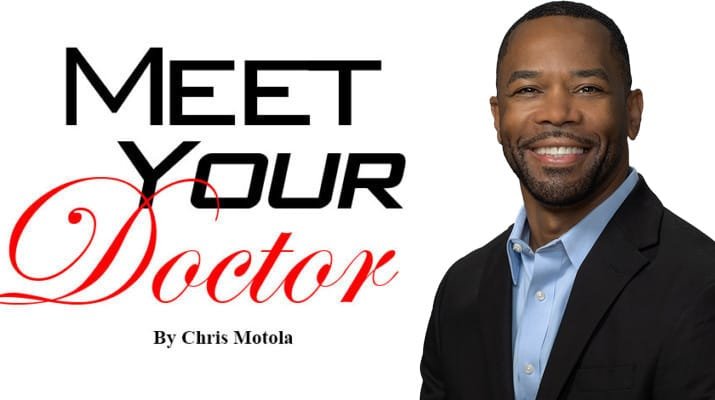Syracuse Community Health Center’s medical director talks about the center’s new state-of-the-art facility in downtown Syracuse and about his five goals: improving health outcomes, cost savings, increasing patient satisfaction, clinical well-being and health equity
By Chris Motola
Q: Syracuse Community Health is building a new state-of-the-art main facility at 930 S. Salina St. How are things coming along at the new site? When do you expect it to open?
A: We should hopefully be relocating in mid-November.
Q: What are some the upgrades patients can expect at the new site?
A: It’s a brand new state-of-the-art facility. Our primary care—including pediatrics, OB-GYN, optometry, dental, podiatry, nutrition — is relocating to the new building. The new building will have a cafe, natural lighting, geothermal heating; it’s a really up-to-date, 2023 kind of building.
Q: Are the hours going to be the same?
A: Currently, on this side, we’re open 8 to 8. Those hours will stay the same for this site, but the new site is going to be 8 a.m. to 5:15 p.m., Monday through Friday. Quick care will remain here, and that’s also open on Saturdays noon to 8 as well.
Q: The current site was the only urgent care facility in downtown Syracuse when it opened. What has utilization been like?
A: It still is the only one downtown. It’s been very busy. We have an agreement with AMR [American Medical Response of CNY] where any patient that they triage who should not go to the emergency department comes to us for quick care so the local hospitals aren’t being backed up and overwhelmed with patients who don’t belong in the ER. So they don’t go to Upstate, they don’t go to St. Joe’s, they don’t go to Crouse, they come here unless we deem it necessary for them to go, then we’ll transfer them. Most of the time these patients don’t need to go to the ER and just need a quick visit.
Q: What are some of the challenges of getting an urban urgent care facility running smoothly compared to, say, one in the suburbs? Are there logistical issues like parking?
A: We actually have a lot of parking. The issue really is staffing. A lot of people don’t want to work until 8 at night. That’s really where the challenge comes in.
Q: Are you drawing from the immediate neighborhoods? Farther away?
A: Definitely many from the immediate neighborhood, but we also get a lot from outside of it, the AMR link. I think also once you develop a reputation for getting patients in and out quickly the word spreads. So we’re getting patients from Liverpool and even as far as Camillus.
Q: Are you able to offer some services that some urgent care facilities can’t?
A: I think that because we have access to podiatry and eye care, so it’s possible to see different specialists in the same day. I think that’s a difference.
Q: What got you interested in the medical director position? Did you always have an administrative focus?
A: It was always a focus. I think working in a primary care office from a young age and learning the operations got me interested in administration, which is why I went to grad school, to focus on administrative work.
Q: What are some of the challenges of running this kind of facility?
A: We’re dealing with a very challenging patient population. They’re underserved, uninsured, suffering from chronic disease or mental health issues. If you get one patient with chronic disease and behavioral health issues, that’s a challenge.
Q: How do you work around that? Does it help to have pools of services?
A: One of the things I’ve done here is integrate behavioral health and primary care so that we’re treating the whole person. It’s a patient-centered kind of treatment that’s been very successful.
Q: Does Syracuse Community Health Center serve as primary care for most of its patients?
A: We’re the primary care for them. When patients come in, they get primary care, pediatrics, OB-GYN. So quick care is for patients who come in with an issue, but we also do regular screenings for diabetes, cholesterol, blood pressure, breast cancer, colorectal cancer. One thing we are able to do is do those routine screenings for patients who many only be seeing a doctor for quick care. You don’t always see that in urgent care.
Q: What level of disease complexity are you able to handle?
A: We manage hypertension, cardiovascular disease, diabetes, COPD. Anything acute we’ll usually treat and then transfer to an emergency department. So if someone comes in with a stroke or heart attack, we’ll do the preliminary testing, diagnose it and transfer them through AMR.
Q: Do you use a particular hospital, or all of the Syracuse hospitals?
A: We use all of them.
Q: What are some of the things you’re working on now, administratively, to make an impact on local healthcare?
A: My whole thing right now is something I call the quintuple aim. Improving health outcomes. Cost savings, patient satisfaction, clinical well-being and health equity. The new building represents healthy equity. We’re one of the poorest zip codes in the country, so for us to have a new state-of-the-art building, that’s health equity. Improving health outcomes means things like making sure patients’ diabetes are controlled, blood pressure is controlled, all their screenings are done. Patient satisfaction is very important. And clinical well-being matters because they’re the ones taking care of the patients. If they’re not doing well, you’re not going to get good outcomes. And cost savings are always important. So that’s the quintuple aim.
Lifelines
Name: Ofrona A. Reid, M.D.
Position: Chief medical officer of Syracuse Community Health
Hometown: Bronx
Education: Ross University School of Medicine; Cornell University
(MBA and MS)
Affiliations: Oneida Health
Organizations: Omega Psi Phi Fraternity
Family: Wife, three children
Hobbies: Church, boating

